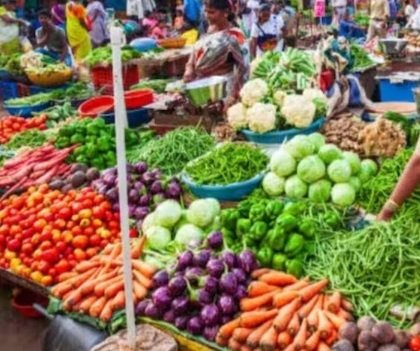By R. Suryamurthy
India’s retail inflation has plummeted to an unprecedented low of 0.25 per cent in October, marking the slowest pace since the Consumer Price Index (CPI) was introduced in 2012. According to data released by the Ministry of Statistics and Programme Implementation, the sharp decline from 1.44 per cent in September signals a rare and encouraging mix of factors — from falling food prices and a robust harvest to the continuing impact of GST rate reductions.
Economists say the steep moderation in inflation underscores the combined effect of cheaper essentials, improved supply conditions, and stabilising input costs across key sectors. Prices of vegetables, pulses, and edible oils have witnessed notable drops, bringing much-needed relief to household budgets after months of volatility.
The biggest driver was food. The Consumer Food Price Index plunged 5.02 per cent year-on-year, compared with a 2.33 per cent fall in September. Prices of vegetables, cereals, fruits, edible oils and eggs all dropped sharply as improved supply and moderating global prices cooled inflationary pressures. Rural food inflation came in at minus 4.85 per cent, while urban areas saw an even steeper fall of minus 5.18 per cent — the lowest since the CPI base year was adopted.
Overall rural inflation slipped into negative territory at minus 0.25 per cent, down from 1.07 per cent a month earlier, while urban inflation eased to 0.88 per cent from 1.83 per cent. Prices of transport, footwear and communication also softened. Housing inflation stayed largely stable at 2.96 per cent, education edged up to 3.49 per cent, and health costs moderated to 3.86 per cent.
The ministry attributed the broad softening to tax reliefs, improved logistics after erratic monsoon disruptions, and falling input costs. But the pattern was uneven. Kerala posted the highest inflation at 8.56 per cent, fuelled by high food and gold prices, while states like Bihar (-1.97%), Uttar Pradesh (-1.71%) and Madhya Pradesh (-1.62%) saw deflation — a sign of subdued demand and falling rural purchasing power.
Economists said the ultra-low reading offers the Reserve Bank of India (RBI) breathing room to begin easing monetary policy. “The headline number was in line with expectations,” said Madan Sabnavis, Chief Economist at Bank of Baroda. “We see average inflation hovering around 2.5 per cent this year before climbing towards 4 per cent by March 2026.” He added that while lower mandi prices for cereals and pulses have temporarily capped inflation, they have also dipped below minimum support prices in some regions, squeezing farmer incomes.
Shivaan Tandon, Asia Economist at Capital Economics, said the near 26-year low in inflation “opens the door for rate cuts.” He expects the RBI to resume easing in December, trimming the policy rate to 5 per cent by early 2026 from 5.5 per cent now. “Inflation is likely to stay below the 4 per cent target for several quarters before inching up again as the base effect fades,” he said.
Aditi Nayar, Chief Economist at ICRA, said the CPI reading was “slightly below expectations” and driven almost entirely by food and beverages deflation, which widened to 3.7 per cent from 1.4 per cent in September. “Sequentially, prices rose just 0.2 per cent month-on-month versus 1.3 per cent last year,” she noted, projecting inflation to edge above 1 per cent in November before gradually rising through 2026.
Upasna Bhardwaj, Chief Economist at Kotak Mahindra Bank, said while inflation remains benign, “the RBI will need to distinguish festive and GST-related demand from a genuine recovery.” She sees room for modest monetary easing if growth momentum remains uncertain.
For now, the October figures offer a welcome respite — a cooling of prices achieved without derailing growth — even if the relief may prove short-lived once the base effect fades and global oil prices turn volatile again.

